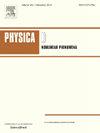Frequency-domain computation of Lyapunov-Perron transformation with detection of quasi-periodic solution bifurcation
IF 2.7
3区 数学
Q1 MATHEMATICS, APPLIED
引用次数: 0
Abstract
Lyapunov-Perron (LP) transformation is well-known as an indispensible technique to reduce a linear quasi-periodic (QP) system, under certain conditions, into a time-invariant one, which we call the reduced system. The reducibility of QP system received a lot of qualitative studies, however quite few research focused on the quantification of the LP transformation itself. The major obstacle probably consists in the calculation of a QP matrix describing the transformation. In this study we will propose a semi-analytical approach, based on frequency-domain analysis, to determine the LP transformation precisely and efficiently. Our approach is divided into two steps. Firstly a constant matrix is determined to represent the reduced system, utilizing the circularly distributed multipliers of the QP system provided by a frequency-domain approach established recently by the authors. With the constant matrix, a linear and solvable QP system governing the transformation matrix is deduced and solved via harmonic balancing, in which the harmonic coefficients are provided by linear algebraic equations. Numerical examples show the semi-analytical results are very accurate for both the constant and the QP matrix, representing the reduced system and the LP transformation, respectively.
As an application, the proposed approach provides us with a convenient way to detect the bifurcation types of QP responses. For instance, the harmonic components of the QP matrix are analyzed for distinguishing saddle-node and symmetry-breaking bifurcations. For a special example where the QP system cannot be reduced via the routine LP transformation, interestingly, it turns out the system reduction can still be realized via an extended transformation. The harmonic components of the QP matrix in the extended transformation can also identify period-doubling bifurcation. Lastly the proposed approach is shown to be capable of detecting QP Hopf bifurcation, exemplified by a van der Pol-Rossler coupled system.
拟周期解分岔检测Lyapunov-Perron变换的频域计算
Lyapunov-Perron (LP)变换是在一定条件下将线性拟周期系统约简为定常系统的一种不可或缺的技术,我们称之为约简系统。QP体系的可约性得到了大量的定性研究,但很少有研究关注LP变换本身的定量化。主要的障碍可能在于描述变换的QP矩阵的计算。在本研究中,我们将提出一种基于频域分析的半解析方法,以精确有效地确定LP变换。我们的方法分为两个步骤。首先,利用作者最近建立的频域方法提供的QP系统的循环分布乘法器,确定一个常数矩阵来表示简化后的系统。利用常矩阵,推导了一个控制变换矩阵的线性可解QP系统,并通过调和平衡求解,其中调和系数由线性代数方程给出。数值算例表明,对于表示简化系统的常数矩阵和表示LP变换的QP矩阵,半解析结果都是非常准确的。作为一种应用,该方法为检测QP响应的分岔类型提供了一种方便的方法。例如,通过分析QP矩阵的谐波分量来区分鞍节点分岔和对称破缺分岔。对于QP系统不能通过常规LP变换进行约简的特殊例子,有趣的是,系统的约简仍然可以通过扩展变换来实现。扩展变换中QP矩阵的谐波分量也能识别倍周期分叉。最后,以van der Pol-Rossler耦合系统为例,证明了该方法能够检测QP Hopf分岔。
本文章由计算机程序翻译,如有差异,请以英文原文为准。
求助全文
约1分钟内获得全文
求助全文
来源期刊

Physica D: Nonlinear Phenomena
物理-物理:数学物理
CiteScore
7.30
自引率
7.50%
发文量
213
审稿时长
65 days
期刊介绍:
Physica D (Nonlinear Phenomena) publishes research and review articles reporting on experimental and theoretical works, techniques and ideas that advance the understanding of nonlinear phenomena. Topics encompass wave motion in physical, chemical and biological systems; physical or biological phenomena governed by nonlinear field equations, including hydrodynamics and turbulence; pattern formation and cooperative phenomena; instability, bifurcations, chaos, and space-time disorder; integrable/Hamiltonian systems; asymptotic analysis and, more generally, mathematical methods for nonlinear systems.
 求助内容:
求助内容: 应助结果提醒方式:
应助结果提醒方式:


